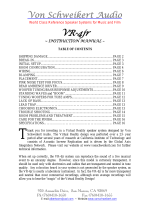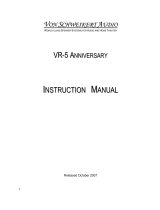Page is loading ...

4. March 2004
CABINETS
Our speaker designs feature massive and inert cabinet
construction. Vienna Acoustics cabinets are designed with the
latest computer modelling techniques and use a combination
of amorphous materials in order to ensure that they are both
stiff and well damped. Additionally, our designs feature narrow
front baffles in order to promote accurate imaging. The
combination of precise build construction using furniture grade
finishing techniques and complex internal damping produce
designs capable of accurately rendering music.
CONNECTIONS
The massive Vienna Acoustics input terminals are designed to
accept banana plugs, spade terminals or bare wire connec-
tion. Make certain that all connections are well tightened
since poor contact between speaker cable and input
connector can lead to degradation of sound quality.
It is also a good idea to make a point of regularly cleaning all
connections in your system since oxidation will build up on a
regular basis. We use gold plated terminals which do not
oxidize, but contaminants or surface build-up on your spea-
ker cables and connectors may degrade sound quality.
While it is popular among some audiophile circles to fit
duplicate sets of binding posts for "bi-wiring", we have cho-
sen to follow sound engineering practises. Our crossovers are
configured as an organic whole, intended to optimize every
known aspect of driver integration.
It is our belief that with the high quality of wire currently
available, it is in most cases possible to obtain higher
performance from a single run of superior cable to two lesser
runs of cable. By keeping a single ground plane in our

crossover design, we are better able to control the many
variables that can be negatively affected by poorly executed
bi-wiring choices. The result for you is consistently superior
musical reproduction.
CABLING
We encourage and recommend the use of high quality speaker
cables and believe them to be an important tool for the
enthusiast in obtaining maximum enjoyment from their music
reproduction system. High quality cabling is a significant tool
in the finetuning of a system for performance. As with any
purchase, listen carefully and allow your ears to guide you.
It is beyond the scope of this manual to provide a useful
compendium concerning cables, or to make specific brand or
model recommendations. A number of high quality maga-zines
do in fact list cable recommendations.
AMPLIFICATION
Our speakers demonstrate outstanding sonic results with a
variety of amplifier types. They feature a combination of high
efficiency and gentle impedance curves that allow them to be
used with either solid state or tube electronics.
However, it is still important to select an amplifier with care
since the full potential of your system will only be revealed by
quality electronics. Amplifier designs do have distinct and
different sounds.
It is important to listen carefully to the match of amplifier and
loudspeaker to ensure that the combination works well
sonically for you. Though rated amplifier wattage bears little

correlation to either sound quality or drive capability the user
is cautioned that amplifiers of low wattage ratings, when
stressed beyond their limits will produce audible amounts of
distortion. This distortion can and will damage loudspeaker
components and will not be covered by warranty.
BURNING OR BREAKING IN NEW
LOUDSPEAKERS
Your loudspeakers contain a large number of precision built
moving parts. These parts require playing time initially to
develop their maximum smoothness and extension. Very
audible improvements can be observed during about 30 hours
of playing. Additional improvements will be evident after 100
hours of playing time, at which point the speakers have
reached their full musical potential.
POSITIONING
Room acoustics and positioning of the speakers within the
room have an important effect on sound quality. To find the
optimal position for your speakers we offer the following hints:
FREE AIR SET-UP
If the room is large and space permits, allow a minimum of 1
meter away from the rear wall (the wall behind the spea-
kers). Small movements of the speaker forwards and
backwards will establish where a speaker sits most com-
fortably. Find the location that gives a full balance without
sounding heavy.
Remember, in a free air set-up the distance from the rear wall
determines how low the speaker will go in a room and also
determines depth of image. Positioning too close to a

rear wall may boost the middle bass frequencies and rob the
speaker of some transparency and precision. In general, it is
best to avoid corner placement of loudspeakers since
the
bass tends to become exaggerated and corners rarely are an
optimal placement for image quality.
NEAR WALL POSITIONING
Many people will simply find it undesirable or disruptive to
place speakers in "free space", that is well away from the
back wall. Vienna Acoustics loudspeakers may be set-up close
to a rear wall, though keep in mind that less toe-in, as
described below, will probably be needed. When working close
to a rear wall, even the tiniest movements will have a
relatively important effect on sound quality. Work slowly and
methodically, following the instructions below and good sound
quality can be achieved.
DISTANCE BETWEEN THE
SPEAKERS AND TOE-IN
Most stereo systems are set-up with their speakers too close
together. As a rough guideline, the distance between spea-
kers should be about 70 % of the room width as a star-ting
point, assuming that your speakers are aiming down the
length of the room.
Too close together and they will create "ghost" images,
double images that blur clarity and focus. Too far apart and
they will begin sounding thin and in extreme cases, will create
separate left and right soundstages. Move them inwards and
outwards, again in small movements as though you were
adjusting the image on a pair of binoculars until a single well-
unified image is obtained.

Toe-In: In an ideal room, the speakers may be set-up so that
the speakers fire directly forward. For the rest of us, some
degree of toe-in, that is rotating the speakers cabinets until
they point at the listener is desirable. Toe-in reduces sidewall
reflections of the mid and upper frequencies. Though one
might reasonably conclude that aiming a speaker at the
listener would result in a brighter sound, this is actually NOT
the case. Toeing a speaker inward will result in a smoother,
warmer and usually more focused sound.
Important Tip:
The distance between speakers is interrelated to the degree
of toe-in. If a speaker loses clarity from toeing in, try
increasing the distance between them slightly. This will have
the effect of "opening up" the speaker and restoring clarity.
ROOM TREATMENT
Good sounding rooms have a well-balanced acoustic. This
does not mean that your home should look like a recording
studio. Commonly found furnishing such as bookshelves,
carpeting and furniture all exhibit beneficial amount of
absorption and dispersion. Rooms with little furniture,
carpeting or other surfaces will demonstrate poor damping and
will produce a hard, bright sound.
As a general rule, it is helpful to have more of these sorts of
things in the space immediately around the speakers than
scattered throughout the space. A thick carpet or area rug
mounted between your listening position and the speakers is
of tremendous benefit in controlling reflections off the floor.
Tapestries, hanging rugs and/or drapes on the side walls hung
slightly ahead of the speaker position will damp reflections off
these surfaces.

OPTIONAL SANDFILLING
Some of our floorstanding models feature an additional hidden
chamber accessible through the base that may be sand filled
for the final touch in system tuning. Sand filling is an
easy and cheap way to improve the reproduction of the bass
range. It raises the weight and stability of the system and
quiets the enclosures throughout a remarkable damping
effect. To fill in the sand, put the speaker on the top on a
soft cloth to protect the cabinet. Then fill in the sand through
the central hole at the base until the chamber is completely
filled up and seal it with the black stubble.
!Do not use moist sand - it can damage the wooden cabinet!
MAINTENANCE
Your speaker cabinets can be cleaned periodically with a soft,
slightly damp cloth. It is not necessary to wax them. Our
cabinets feature a smooth but strong finish. Still, please keep
them out of direct sunlight and heat, since the colour of the
veneer would pale. Should the bass drivers become dusty, it
is safe to use a soft brush to clean the woofers.
* Under NO circumstances should you attempt to clean dust
from the tweeter. Doing so will damage the delicate silk
domes.

Additional Instructions
for
STRAUSS
Please take care of further important features of STRAUSS: On the backside of
STRAUSS, on the terminal, under the binding posts, you will find a sinking,
housing a tiny switch, possible to be moved by any sharp tool like a spike. This
is an important room tuning aid: It allows you to influence high frequencies.
Symbols:
N is for Neutral
- is for smoothened tweeter response.
This switch provides you with the perfection in room tuning: In Neutral-position
the switch has no connection to the crossover, but with the lowering switch
position you are able to fine-tune on conditions like bright sounding, reflective
rooms, echoing undamped walls, or any other “cold” circumstances like
analytical electronic environment, gaining back the so important natural
balance.
You can influence STRAUSS´ environment not only with the switches, but by
positioning STRAUSS regarding his basses on the side. As they are mounted on
one side of the cabinet (left and right speaker), it is possible to let them fire
inwards or outwards and so to influence the bass response to match room
acoustic. This room-tuning is made possible by the bass-modes in a room,
which change immediately by being stimulated on different places. As an
indication, in most cases a positioning with basses outwards creates a more
powerful bass response, whereas basses inwards tend to more slender bass
reaction. We suggest to start with position “outwards“.
Base mounting:
The beautiful lyric base decouples the frontplate and features a choice of
adjustable 3-spike-point or 4-spike-point application:
We suggest to use the 4-spike-point application, both for perfect weight
allocation (when fine-tuned thoroughly by yourself with adjusting the spikes to
the surface of your floor), and for maximum safety in terms of stability.
The 3-spike-point application provides the weight allocation automatically, but
may only be used in safe circumstances, with no persons or animals possible
to collide with the speaker however.

www.vienna-acoustics.com
/






